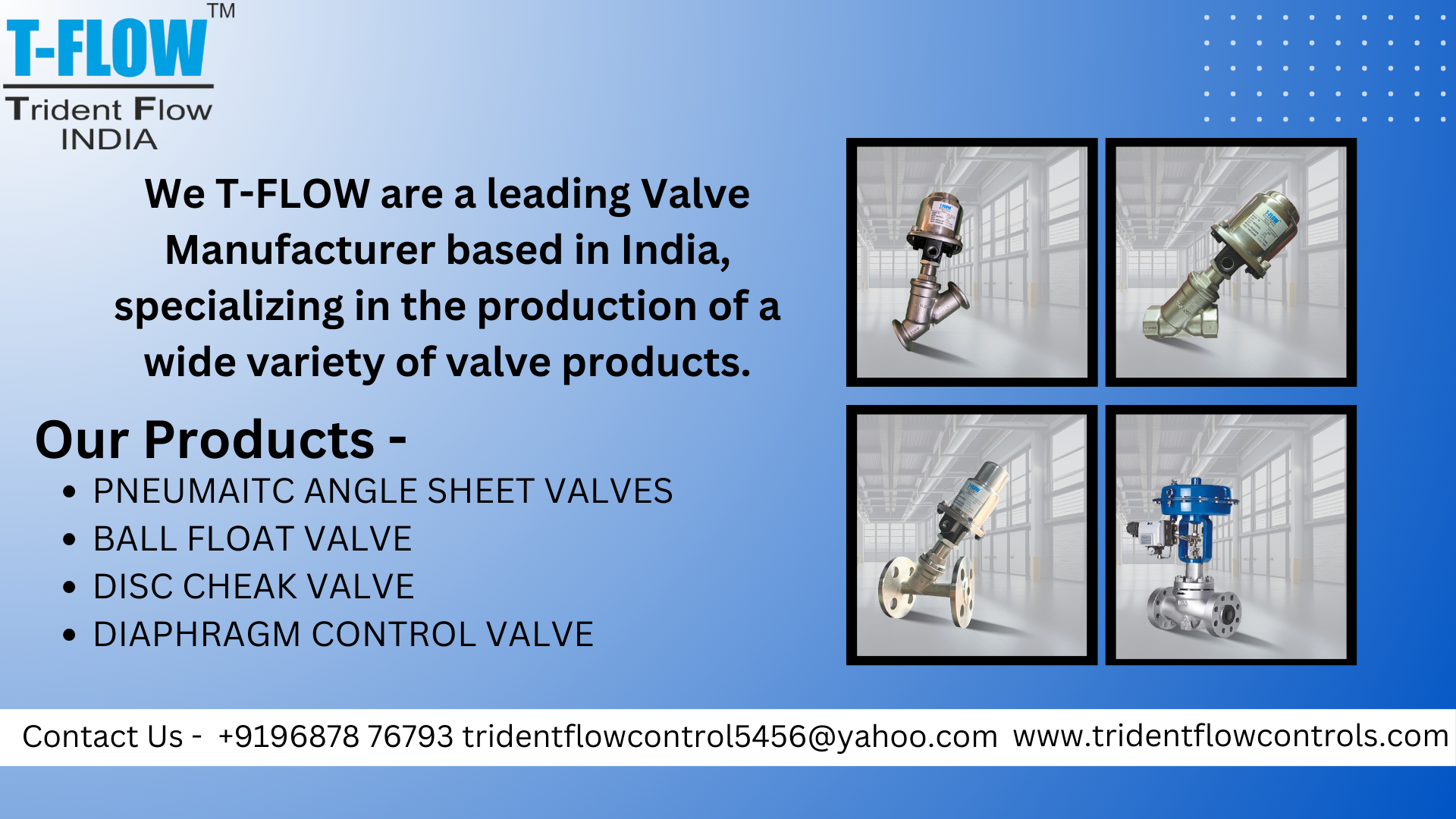
Diaphragm Control Valve Types
Diaphragm
Control Valve Types
A Diaphragm Control Valve is a type of throttling
valve used to regulate fluid flow by varying the size of the flow passage. It
uses a flexible diaphragm that moves up and down against a contoured
weir or seat to modulate the flow. These valves are known for their leak-tight
performance, corrosion resistance, and sanitary design,
making them suitable for highly sensitive or aggressive processes.
Diaphragm control valves are commonly used in pharmaceutical,food & beverage, chemical, semiconductor, watertreatment, and biotechnology industries. Depending on the
application, they come in various configurations such as manual, pneumatically
actuated, or electrically controlled, offering precise flow
regulation and automated control.
Applications
of Diaphragm Control Valves
- Pharmaceutical
& Biotech – Flow control in sterile, clean-in-place (CIP) processes.
- Food
& Beverage – Regulating beverage syrup, dairy liquids, and brewing
operations.
- Chemical
Industry – Precise control of corrosive or toxic chemicals.
- Water
Treatment Plants – Dosing, chlorination, and chemical mixing lines.
- Pulp
& Paper Industry – Bleach and chemical concentration control.
- Semiconductors
– Handling ultra-pure water and chemicals.
- Cosmetics
– Metered dosing of viscous fluids.
- Mining
– Slurry and reagent flow control.
- Power
Plants – Deionized water regulation.
- Medical
Devices Manufacturing – Fluid delivery control in sterile conditions.
Features
and Their Uses
|
Feature |
Use/Benefit |
|
Modulating Control Function |
Allows precise throttling of flow between fully open and closed. |
Flexible Diaphragm |
Provides leak-tight sealing and isolates the fluid from
moving parts. |
|
Pneumatic or Electric Actuation |
Enables remote control and automation of flow processes. |
|
Compact & Hygienic Design |
Ideal for sterile or space-restricted installations. |
|
Corrosion-Resistant Materials |
Suitable for acids, alkalis, and reactive chemicals. |
|
Low Maintenance |
Minimal moving parts reduce wear and service frequency. |
|
Top-Entry Design |
Easy access for diaphragm replacement and inspection. |
|
Bubble-Tight Shutoff |
Ensures safe handling of toxic or hazardous media. |
|
Dead-Leg-Free Construction |
Eliminates fluid retention, ideal for pharmaceutical-grade
processes. |
|
Position Feedback Option |
Available for integration with PLC/SCADA systems for
monitoring and control. |
Key
Points to Consider
- ✅ High accuracy in flow regulation
- ✅
Ideal for slurry, viscous, and aggressive media
- ✅
Compatible with sterile & cleanroom operations
- ✅
No contamination from valve internals
- ✅
Energy-efficient pneumatic or electric actuation
- ✅
Multiple body and diaphragm material options
- ✅
Compact, modular, and repairable designs
- ✅
Manual override available in some models
- ✅
Smooth flow path with low pressure drop
- ✅
Excellent for throttling + shutoff combined
Top 10
FAQs – Diaphragm Control Valves
- Q:
What is a diaphragm control valve used for?
A: It is used to regulate flow and pressure of fluids with high precision in various industrial processes. - Q:
How is it different from an on/off diaphragm valve?
A: Control valves modulate flow continuously, while on/off valves only fully open or close. - Q:
What actuators are used in diaphragm control valves?
A: Pneumatic, electric, and occasionally hydraulic actuators are used based on process needs. - Q:
Can diaphragm control valves handle corrosive fluids?
A: Yes, especially with PTFE, PVDF, or EPDM diaphragms and body materials like stainless steel or plastic. - Q:
Are diaphragm control valves suitable for sterile environments?
A: Absolutely. They're widely used in pharma and biotech for sterile and CIP/SIP applications. - Q:
What sizes are available for diaphragm control valves?
A: Ranges typically from 1/2” to 6” (DN15 to DN150) depending on the manufacturer. - Q:
Can these valves be used in vacuum systems?
A: Yes, they provide excellent shutoff and control even under vacuum conditions. - Q:
How are diaphragm valves controlled automatically?
A: Using positioners, controllers, and actuators that respond to flow or pressure signals. - Q:
Do diaphragm control valves support feedback systems?
A: Yes, many come with feedback sensors or transmitters for integration with PLC/SCADA. - Q:
How often does the diaphragm need replacement?
A: It depends on fluid type and cycle frequency; typically every 1–2 years under normal usage.
Types of
Diaphragm Control Valves
|
Type |
Description |
|
Weir-Type Control Valve |
Best for throttling and flow regulation; minimal dead space. |
Straight-Through Control Valve |
Provides unobstructed flow; ideal for slurries and viscous
media. |
|
Manual Control Diaphragm Valve |
Operated by handwheel with fine adjustment for flow
control. |
|
Pneumatically Actuated Valve |
Uses compressed air for modulating control; fast and
reliable in automation. |
|
Electrically Actuated Valve |
Uses electric motor or solenoid for precise and
programmable control. |
|
Hygienic/Sanitary Control Valve |
Designed per ASME BPE for sterile applications in
pharma/food. |
|
Plastic Body Control Valve |
Lightweight, corrosion-proof; used in chemical dosing and
water systems. |
|
Stainless Steel Body Valve |
Durable, hygienic, and pressure-resistant; used in
high-purity and process plants. |
|
Diaphragm Valve with Positioner |
Smart control with feedback for accurate valve
positioning. |
|
Multi-Turn or Linear Travel Valve |
For precision regulation over a wide range of flow. |
Contact
Us For More Details On :
Call –
9687876793
Email - tridentflowcontrol5456@yahoo.com
Website –
www. tridentflowcontrols.com
Address -
90, Vrundavan Estate, Opp. Vijay Estate, Bhikshuk Gruh, Odhav, Ahmedabad-382
415.
YouTube -
www.youtube.com/@tridentflowcontrols
Instagram
- www.instagram.com/trident_flow
Quick Links
Our Products
Get In Touch
90, Vrundavan Estate, Opp. Vijay Estate, Bhikshuk Gruh, Odhav, Ahmedabad-382 415.
tridentflowcontrol5456@yahoo.com
tridentflowcontrol5456@yahoo.com
9687876793
T-FLOW 2023-2024 | All Rights Reserved. Design and Developed by Industry Lead -8000121171
